The History Of FORD Mondeo

The Ford Mondeo is a large family car sold by the Ford Motor Company in various markets throughout the world. The name "Mondeo" derives from the Latin word mundus, meaning "world". The initial generation of the Mondeo was developed as a "world car", along with North American models marketed as the Ford Contour and Mercury Mystique until 2000.
Mk1
Although an official picture was published at the end of 1992, with a mention in the Auto Car magazine on 2 December 1992, which showed pictures and details of Ford's future in the fiercely competitive large family car sector, The Mondeo was launched on 8 January 1993, and sales began on 22 March 1993. Available as a four-door saloon, a five-door hatchback, and a five-door estate, all models were produced at Ford's plant in the Belgian city of Genk. The Sierra had been built there since its launch in 1982, although until 1989, right hand drive Sierras had also been built in UK at the Dagenham plant.
Intended as a world car, it replaced the Ford Sierra in Europe, the Ford Telstar in a large portion of Asia and other markets, while the Contour and Mercury Mystique replaced the Ford Tempo and Mercury Topaz in North America. Unlike the Sierra, the Mondeo is front-wheel drive in its most common form, with a rarer four-wheel drive version available on the Mk1 car only. Instigated in 1986, the design of the car cost Ford US$6 billion. It was one of the most expensive new car programs ever. The Mondeo was significant as its design and marketing was shared between Ford USA in Dearborn, and Ford of Europe. Its codename while under development reflected thus: CDW27 signified that it straddled the C & D size classes and was a "World Car".
The car was launched in the midst of turbulent times at Ford of Europe, when the division was haemorrhaging hundreds of millions of dollars,[citation needed] and had gained a reputation in the motoring press for selling products which had been designed by accountants rather than engineers. The fourth generation Escort and Orion of 1990 was the zenith of this cost-cutting/ high price philosophy which was by then beginning to backfire on Ford, with the cars being slated for their sub standard ride and handling, though a facelift in 1992 had seen things improve a little. The Sierra had sold well, but not as well as the all-conquering Cortina before it, and in Britain, it had been overtaken in the sales charts by the newer Vauxhall Cavalier. Previously loyal customers were already turning to rival products and by the time of the Mondeo's launch, the future of Europe as a Ford manufacturing base was hanging in the balance. The new car had to be good, and it had to sell.
Despite being billed as a world car, the only external items the Mondeo shared with the Contour were the windscreen, front windows, front mirrors and door handles. Even the interior was slightly different. The CDW27 project turned out not to be a true world car in the sense that the original Ford Focus was; one design for the world.
Design and engineering
A large proportion of the high development cost was due to the Mondeo being a completely new design, sharing very little, if anything, with the Ford Sierra. Using an all-new platform, the Mondeo featured new manual and automatic transmissions and sophisticated suspension design, which Ford hope would give it class-leading handling and ride qualities, and subframes front and rear to give it executive car refinement. The automatic transmission featured electronic control with sport and economy modes plus switchable overdrive.
Safety was a high priority in the Mondeo design with a driver's side airbag (it was the first ever car sold from the beginning with a driver's airbag in all of its versions, which helped it achieve the ECOTY title in 1993) side-impact bars, seat belt pretensioners, and ABS (higher models) as standard features. Other features for its year included adaptive damping, self-leveling suspension (top station wagon models), traction control (V6 and 4WD versions), and heated front windscreen, branded Quickclear.
The interiors were usually well appointed, featuring velour trim, an arm rest with CD and tape storage, central locking (frequently remote), power windows (all round on higher models), power mirrors, flat-folding rear seats, etc. Higher specification models had leather seats, trip computers, electric sunroof, CD changer and alloy wheels.
During its development, Ford used the 1986 Honda Accord and Nissan Primera as the class benchmarks that the CDW27 had to beat.
Engines
Along with an all-new platform, the Mondeo also used Ford's then-new Zetec engines, first seen in 1991 in the Ford Escort and Fiesta.
Three versions of the 16-valve Zetec engine were used. The 1.6 L version (rated at 90 bhp) from the Escort was used, a 1.8 (115bhp) also found in the Escort and Fiesta (105/ 130bhp), while a new 136 bhp 2.0 L version was launched.
An alternative to the Zetec engines was the Endura-D 1.8 L turbodiesel. This engine had origins in the older 1.6 L diesel design used in the Fiesta and elsewhere. Although not without merits, it was not seen as a strong competitor to other European diesels such as that produced by Peugeot. The contrast between this unit and the competition seemed enormous by the time the engine was dropped in 2000.
A less popular engine (for the UK and Ireland) was introduced in 1994 in the form of the 170 bhp 2.5 L 24-valve V6 Duratec unit, primarily included for markets where four-cylinder petrol engines are not favored and are usually intended for the upmarket European buyer. This engine, first unveiled in the Mondeo's North American cousin, the Ford Contour, is characterized by its smooth operation, chain-driven camshafts and an ability to operate using only half its 24 valves at low engine speeds. Fuel economy was reasonable, with the automatic barely much worse than the manual (but far less reliable). This engine was originally branded 24v (when valve count was all important), but later on sold as the more glamorous sounding V6.
This engine was also used to introduce the new "ST" (Sports Technology) brand to the Mondeo range as a flagship model, the ST24 in 1997. The power of the engine stayed at 170 bhp, the same as other 2.5 L-engined models, but the ST featured unique cabin trim, unique 16 in alloy wheels, and a full RSA (Rally Sport Appearance) bodykit as standard. The bodykit option was listed as a delete option for those that did not want it fitted as standard. This was later replaced by the Limited Edition ST200 in 2000, featuring a modified version of the V6 Duratec with a power output of 200 bhp.
Although neither of these models ever sold in high numbers, the marketing was important to Ford as it was an introduction to the ST range as a sportier side to the full range, especially significant as apart from the Focus RS, both the XR and RS model ranges were phased out during the 1990s.
Trim levels
The 1993-1996 range had the following trim levels:
UK market- Base - 1.6L Zetec, 1.8 L turbodiesel, base trim level, 4-door saloon, 5-door liftback, estate (replaced by Aspen in 1995)
- Aspen - 1.6 L Zetec, 1.8 L turbodiesel, base trim level, 5-door liftback, estate
- LX - 1.6 L/ 1.8 L/ 2.0 L Zetec, 1.8 L turbodiesel, midrange trim level, 4-door sedan, 5-door liftback, estate
- GLX - 1.6 L/ 1.8 L/ 2.0 L Zetec, 1.8 L turbodiesel, luxury trim level version of the LX, 4-door saloon, 5-door liftback, estate
- 24v - 2.5L Duratec V6, 4-door saloon, 5-door liftback, estate (1994-1995 only)
- Ghia - 1.8 L/ 2.0 L Zetec, 2.5 L Duratec V6, 1.8 L turbodiesel, midrange trim level, 4-door sedan, 5-door liftback, estate, optional 4x4 on 2.0L Zetec
- Ghia X - 2.0L Zetec, 2.5 L Duratec V6, 1.8L turbodiesel, luxury trim level, 4-door sedan, 5-door liftback, 5-door estate (from 1995), optional 4x4 on 2.0L Zetec
- Si - 2.0 L 4-cylinder, 2.5 L Duratec V6, sports version, 4-door sedan, 5-door liftback, estate, optional 4x4 on 2.0L Zetec
Additional trim levels in other European markets included:
- Mirage - 1.6 L Zetec, base trim level, 4-door sedan, 5-door liftback, estate - only offered in the Netherlands
- CLX - 1.6 L/ 1.8 L/ 2.0 L Zetec, 1.8 L turbodiesel, midrange trim level, 4-door sedan, 5-door liftback, estate - not offered in UK
- Verona - 1.8 L, midrange trim level, 4-door saloon, 5-door liftback
- GLX - 1.6 L/ 1.8 L/ 2.0 L Zetec, 1.8 L turbodiesel, luxury trim level version of the CLX, 4-door saloon, 5-door liftback, estate
- Business Edition - 1.6 L/ 1.8 L/ 2.0 L 4-cylinder, 2.5 L V6, 1.8 L turbodiesel, luxury trim level version of LX, 4-door sedan, 5-door liftback, estate. - only offered in the Netherlands
- GT - 1.8 L/ 2.0 L 4-cylinder, 2.5 L V6, 1.8 L turbodiesel, sports version, 4-door sedan, 5-door liftback, estate. Only offered in the Netherlands, equivalent to UK-spec Si
- V6 - 2.5 L V6, luxury version, 4-door sedan, 5-door liftback, estate. Never offered with a V6 (base) in the Netherlands, only Business Edition or GT.
Mk2
Referred to as the Mk2 Mondeo, a major facelifted version launched in October 1996 saw three of the Mondeo's biggest criticisms addressed: its bland styling, the bad performance of the headlights, and the cramped rear legroom. The lowering of specification levels around that time (e.g. air-conditioning and alloy wheels became optional on the UK Ghia models) may have indicated a desire by Ford to cut costs and recoup some of the huge sums invested in the original design. These specification levels were improved again in 1998 as the Mondeo approached replacement.
The facelift saw almost every external panel replaced, leaving only the doors and roof the same as the original Mk1 model. Even the extractor vents on the rear doors were replaced by a panel bearing the name Mondeo. The most notable change was the introduction of a version of Ford's corporate 'oval' grille. The saloon version featured some distinctive rear lights. These incorporated an additional reflector panel that extended around the top and the side of the rear wings. Unlike the iterations seen on the heavily facelifted Scorpio and Mk4 Fiesta during the previous year, this facelift was well-received.
The interior was also mildly revised though the basic dashboard architecture was the same as before. Safety specification was improved, with the car gaining a full-size driver airbag in place of the smaller 'euro-bag' fitted in the MK1 Mondeo. The MK2 gained a 'flagged' 3 star rating in EUORNCAP testing, which was average for rivals of its time (the same as the Vauxhall Vectra, better than the Citroen Xantia and worse than the Nissan Primera).
The Zetec engine was thoroughly revised in 1998 which was far more refined and smoother which was something the original engine lacked at high revs.
Mixed sales success
In Europe, the Mondeo was instantly declared a class leader, and was elected Car of the Year in 1994.
Ford briefly sold a version using the 2.0 L Zetec engine and four-wheel drive, available between 1995 and 1996 on cars with Si, Ghia and Ghia X trim. The timing was not ideal though as four-wheel drive had already become synonymous with large SUVs such as the Land Rover Discovery, and the bottom dropped out of the four-wheel drive sedan market.[citation needed] People who would tolerate the knock on performance and economy, preferred to graduate to a full-blown SUV, rather than a sedan with good all-round traction; especially since SUVs had become fashionable at the time.
In Europe, the Mondeo is considered large, but in other markets such as the United States and Australia, it had not fared well, as there were larger models that had stronger brand loyalty and offered better value for money. Ford claimed that it was a 'world car', but in a letter to Autocar magazine in the UK, a Ford dealer retorted 'What world was it designed for?' Because of this, the Contour and Mystique proved unpopular with American buyers. While the Contour sold at an average rate, the Mystique fizzled. The Mondeo Mk3 was much larger than the Mk1/ 2 version, but was not sold in the United States and Canada, where Ford now offers the Fusion.
There is however another theory advanced by some motoring journalists: that because the Contour and Mystique were not created in the United States, it suffered from a lack of enthusiasm from inside Ford's North American operations. Those same theorists point to the fact that the BMW 3 Series — arguably a "world car" in the sense, one version is sold globally — does quite well in the United States and it is the same size as the Contour and Mystique.
The Mondeo was released in Australia in 1995, but was not a sales success, where, similarly, there was a much larger local model, the Falcon, and was dropped in 2001. Ford Australia withdrew completely from the medium-sized segment of the Australian market, arguing that it was in decline. The wagon version, the first medium-sized Ford of its kind to be sold in Australia since the Cortina, was dropped in 1999. It struggled against Japanese models such as the Honda Accord and Subaru Liberty, as well as the Holden Vectra, also imported from Europe, although unlike the Mondeo, briefly assembled locally. The Mondeo has since been returned to Australia in 2007 with an all-new model.
By contrast, the Mondeo (like the Cortina long before it) was a success story in New Zealand, the Mk3 model in particular being voted Car of the Year in 2001 by Autocar New Zealand and National Business Review. In addition, many earlier model Mondeos, imported used from Japan were also sold locally (Japan was also a good market for the Mondeo, a rare feat in a country with a high proportion of domestic automobiles). It was launched to replace the Telstar in New Zealand following the plant closure in 1997.
In Australia, the 1995-2001 Ford Mondeo was assessed in the Used Car Safety Ratings 2006 as providing "significantly better than average" protection for its occupants in the event of a crash.
In its final year in China the Ford Mondeo M2000 gained a front fascia not dissimilar from the outgoing Mercury Mystique's but had Ford badges. Its rear end was identical to that of the European models.
Trim levels
The 1997-2000 range had the following trim levels:
- Aspen - 1.6 L Zetec, 1.8 L TD Endura, base trim level, 5dr, Estate
- LX - 1.6/ 1.8/ 2.0 L Zetec, 1.8 L TD Endura, midrange trim level, 4dr, 5dr, Estate
- Verona - 1.8 L Zetec, midrange trim level, 5dr
- GLX - 1.8/ 2.0 L Zetec, 1.8 L TD Endura, midrange trim level, 4dr, 5dr, Estate
- Si - 2.0 L Zetec, 2.5 L V6 170 PS, sports version, 4dr, 5dr, Estate
- Zetec - 1.8/ 2.0 L Zetec, replaced Si, 5dr, Estate
- Zetec-S - 2.0 L Zetec, rare Zetec based special edition with ST bodykit, 5dr
- Ghia - 2.0 L Zetec, 2.5 L V6 170 PS, 1.8 L TD Endura, luxury trim level
- Ghia X - 2.0 L Zetec, 2.5 L V6 170 PS, 1.8 L TD Endura, top spec trim level
- ST24 - 2.5 L V6 170 PS, Sports Variant Luxury bucket seat half leather trim, sports-suspension, RSAP Kit
- ST200 - 2.5 L V6 205 PS, Sports Variant, Luxury Recaro leather trim, tuned engine & suspension, RSAP Kit, digital Climate Control
In South Africa, the trim levels offered were:
- LX - 1.8 L Zetec, midrange trim level, 4-door sedan
- CLX - 2.0 L Zetec, midrange trim level, 4-door sedan
- 2.0 Aspen - 2.0 L Zetec, luxury trim level version of the LX, 4-door sedan
- Si - 2.5 L V6, sports version, 5-door liftback,
Sports variants
Mondeo Mk2 sports variants included the ST24 and the ST200. The ST24 produced 170bhp (130kW) from its 2.5 litre V6 24v engine and was launched with RSAP (Rally Sport Appearance Pack) bodykit along with sports suspension and half-leather sports bucket-seats. Its standard setup saw the ST24 from standstill to 62mph (100km/ h) in around 8 seconds, coupled with a maximum speed of 139mph (224km/ h). North America got a SE "Sport" Version of the contour which featured exclusive wheels and the coveted 9" Sport Drum rear brakes. Rear Disc brakes eventually became available in North America on Certain Contour and Mystique models.
The ST200 was then launched as the Enthusiast's car, with a tuned 2.5 litre V6 24v engine producing 202bhp (151kW). This engine made the ST200 go from standing to 62mph (100km/ h) in around 7.7 seconds, and reach a maximum speed of 141mph (227km/ h). Tuning included a different throttle body, cams, flywheel, and upper manifold to name a couple. This version of the Mondeo also had even better sports suspension than the ST24, and came with full-leather Recaro sports bucket-seats. The ST200 was only released to the public in Imperial Blue colour and a very limited number in white (mainly for use by the police). The North American counterpart to this model was known as the Ford Contour SVT.
In 1998, Ford released in Europe a sports car with a coupé bodyshell based upon the MK2 Mondeo called the Ford Cougar (or Mercury Cougar in north America. This car shared the engines (2.0 I4, 2.5 V6), transmissions, suspension (partially) and floorpans from the Mondeo, but the bodyshell was unique to the Cougar and was one of the last Ford cars to be designed under Ford's New Edge philosophy.
Contemporaries
- Citroën Xantia
- Fiat Tempra
- Fiat Marea
- Honda Accord
- Mazda 626
- Nissan Primera
- Peugeot 405
- Peugeot 406
- Renault Laguna
- Rover 600
- Toyota Carina
- Vauxhall Cavalier
- Vauxhall Vectra
- Volkswagen Passat
Launched in October 2000, and seen as the third generation model, this Mondeo was considerably larger than its predecessor. Although Ford abandoned its New Edge design theme for the Mondeo Mk3, it still borrowed some styling cues from the Focus Mk1, giving it an overall effect which many critics felt was more restrained and mature than the Focus, if much less distinctive. Two of the old car's biggest weaknesses, the modest rear legroom, and uncompetitive diesel version were addressed by a longer wheelbase and the new Duratorq diesel engine. The basic chassis and suspension design was carried over from the previous generation, which meant that the car continued its predecessor's reputation for class leading handling and ride.
Following the standard setting interior of the Volkswagen Passat Mk4 in 1996, Ford paid a great deal of attention to the Mk3's interior and was the first mainstream manufacturer to react to the new standard set by Volkswagen. Ford dispensed with the rounded American style interior of the Mk1, and developed a more sober 'Germanic' design, which not only seemed more sophisticated but, more importantly, was of a higher quality due to the use of more expensive materials.
As with its predecessor, passive safety was a major selling point of the 2000 Mondeo. With an even stronger bodyshell, Ford introduced its so-called "Intelligent Protection System" (IPS), which used an "intelligent" array of sensors based on a neural network, to decide the best combination of safety devices (traditional front passenger airbags, side airbags and curtain airbags) to deploy for a given crash situation. To enhance active safety, all models were fitted with anti-lock brakes and electronic brake-force distribution, with electronic stability program (ESP) available as an option. Ford's marketing of the time claimed the Mondeo was 'One of the safest places to be'. However, EURONCAP testing of the Mk3 found that it protected worse than most key rivals (Vectra, C5, Avensis, Laguna), achieving a lower-end 4 star rating. Ford redesigned part of the car and it was re-tested, but the higher-than-average risk of chest injury to the driver in the frontal impact remained.
The Mondeo established itself as Britain's most popular automobile in its class and held this position every year from 2001 onwards, though this size of car has fallen slightly in popularity during the 2000s. This version of the Mondeo has never come higher than sixth in the SMMT's official list of the top selling cars in the UK each year. In 2003, it came tenth in the list.
Engines
For the Mk3, the Zetec engine was dropped, while the all-new 1.8 and 2.0 L Duratec engines were introduced. The standard 2.5 L V6 engine was carried over, while a 3.0 L version was developed for the ST220 model.
Unfortunately there was a design flaw with the new 1.8 and 2.0 L petrol units with the butterfly valves in the inlet manifold which could cause severe engine damage when the butterfly valves failed. The plastic components of the butterfly valves wear out too quickly and when loose enough can result in them falling apart and releasing metal and plastic parts into the engine cylinders potentially causing severe engine damage. The part was uprated by Ford in late 2002 to early 2003 and this solved the problem occurring in future cases.
The archaic Endura-E 1.8 L turbodiesel engine was dropped, and replaced by a more sophisticated 2.0 L 16v Duratorq common rail (TDCi) unit with a variable geometry turbine. This clever turbine system allows a certain amount of overboost, giving an extra 10% or so of torque for short periods. This engine, known within Ford as the "Puma"-type Duratorq, was first seen in the Transit in detuned form.
A new automatic transmission was added to the range called the Durashift. This unit has five gears and may be shifted manually or shifted like an automatic.
In June 2003, the Mondeo was given a very mild upgrade, the new models being identifiable by the larger chrome honeycomb grille, a new central dashboard made from higher quality materials, with electronic climate control, either a standard Ford radio, Sony radio, or a satellite navigation radio/ CD player, which also has climate control built into the unit in lieu of the space taken up by the unit. The Durashift automatic is now available with steering wheel control, while a 96 kW (130 PS) common rail version of the Duratorq turbodiesel engine became available. The petrol engines were revised at this stage also — the new SCI (common rail) version of the 1.8 L Duratec engine was introduced, which generates 4 kW (5 PS) more than the standard unit. In addition, equipment was upgraded across the range — with trip computer now standard on all models, and cruise control is also standard in selected markets.
In 2005, there were two new Duratorq common rail (TDCi) options, a 2.2L with 114 kW (155 PS) and a detuned version of the 2.0L with 65 kW (89 PS). Also, the Seat Belt Warning System was added and is now standard, with an audible/ visual warning signal reminding the driver to fasten his/ her seat belt. The styling was upgraded again, the most notable difference being tweaked taillights.
Europe/ Eastern Asia
Engines:
- 1.8L (1798cc) Duratec I4, 110PS (108hp/ 81kW) and 122lb·ft (165N·m) (1.8)
- 1.8L (1798cc) Duratec I4, 125PS (123hp/ 92kW) and 125lb·ft (170N·m) (1.8)
- 1.8L (1798cc) Duratec SCi I4, 131PS (129hp/ 96kW) and 129lb·ft (175N·m) (1.8 SCi)
- 2.0L (1999cc) Duratec I4, 146PS (144hp/ 107kW) and 140lb·ft (190N·m) (2.0)
- 2.5L (2495cc) AJ25 V6, 170PS (168hp/ 125kW) and 162lb·ft (220N·m) (2.5)
- 3.0L (2967cc) Duratec 30 V6, 204PS (201hp/ 150kW) and 207lb·ft (280N·m) (3.0)
- 3.0L (2967cc) Duratec 30 V6, 226PS (223hp/ 166kW) and 210lb·ft (285N·m) (3.0 ST220)
- 2.0L (1998cc) Duratorq I4, 90PS (89hp/ 66kW) and 155lb·ft (210N·m) (2.0 TDDi 90)
- 2.0L (1998cc) Duratorq I4, 116PS (114hp/ 85kW) and 207lb·ft (280N·m) (2.0 TDCi 115)
- 2.0L (1998cc) Duratorq I4, 131PS (129hp/ 96kW) and 244lb·ft (330N·m) (2.0 TDCi 130)
- 2.2L (2198cc) Duratorq I4, 155PS (153hp/ 114kW) and 265lb·ft (360N·m) (2.2 TDCi 155)
The fourth generation Mondeo (codename: CD345) was officially unveiled in 5-door production form in late 2006. Based on the EUCD platform developed with Volvo, the platform is the same used in the new large MPVs Galaxy and S-MAX, but not the North American Ford Fusion or the Mazda6 in Japan. It will also possibly be used for several Volvos.
The Mk4 Ford Mondeo was released in May 2007 in the UK where it is currently available in five different trim levels: Edge, Zetec, Ghia, Titanium and Titanium X. In February 2008, Ford announced that in some European markets the Mondeo will be made available with a new Titanium S series trim. This model aims to add an even more 'sporty character' than the current Titanium series. In March 2008, a new 2.2 175PS (128.7kW; 172.6bhp) TDCi common-rail diesel engine will be available on Mondeo providing excellent power accelerating 0-60 mph in 8.4 seconds on the saloon and great fuel performance returning 45.6 mpg[clarification needed] combined. Also available in March 2008 will be Mondeo ECOnetic based on the Zetec series. The Mondeo ECOnetic is powered with a 1.8 125PS (91.9kW; 123.3bhp) TDCI diesel that returns CO2 ratings of just 139 g/ km on the 5 door.
Although the fourth production model, after the Mk3 Galaxy, S-MAX and C-MAX, to adopt Ford's current 'kinetic' design language, the Mondeo's design theme was first shown at the 2005 Frankfurt Motor Show, which gave an indication to the look of the Mk4 Mondeo. The new car, in estate bodystyle, was pre-launched in 'concept' form at the Paris Motor Show on 30 September 2006.
The new platform will allow for the use of Volvo’s five-cylinder petrol engine, already featured in the Focus ST and S-Max. The petrol engines include a 1.6-litre with two power outputs (110 PS & 125 PS), the 2.0-litre (145 PS), 2.3-litre (161 PS) for automatic models only, and a 2.5-litre five cylinder turbo with 220PS (162kW; 217hp). Performance models may come with engines from Jaguar and Volvo.
The new Mondeo uses the new electro-hydraulic steering system, first used on the C-MAX, that sharpens the steering response, and helps to save fuel Inside, the Mk4 features Ford's Human-Machine Interface (HMI) first seen on the Galaxy and S-Max whilst an enhanced instrument cluster featuring a 5 inch LCD for displaying trip computer and satellite navigation is standard on Titanium level models and available as an option on others. As has historically been the case with new Ford models, equipment levels have been downgraded slightly from the preceding generation - base specification models now have a manual heating/ air-conditioning system in place of the climate control which was standard across all versions of the facelift Mk3. Also new on the Mk4 is the option of keyless starting of the engine via a "Ford Power" button on the dashboard.
A product placement promotional initiative made the Mk4 Mondeo James Bond's car for one incidental scene in Casino Royale, introducing the new model to global audiences in November 2006 on the launch day of the movie. Ford Group models have been prominent in the Bond franchise since 2002's Die Another Day, which featured an Aston Martin, a Jaguar convertible, and a Ford Thunderbird.
As with the previous model, the Mk4 Mondeo is not marketed in the US or Canada because Ford currently sells the same-class Fusion, which was launched in 2005. The new Mondeo is not sold currently in Venezuela, Brazil or Colombia because the Fusion is sold locally, nor is it offered in Mexico, although the MK3 model was popular there. It is, however, sold in Argentina.
The 2007 Mondeo marked the return to the Australian market after a six-year absence, due to a resurgence in popularity of medium-sized cars in the last few years. This is in no small part the result of high fuel prices making people reconsider purchasing large cars like the Ford Falcon. Marketing for the Mondeo in Australia has so far focused on the theme that the Mondeo looks good but offers even more than style, with television commercials showing silly quotes from celebrities such as Britney Spears ("I've been to lots of overseas places... like Canada") interspersed with scenes of the vehicle and finally the slogan "more than just good looks".
The Australian spec Mondeo TDCi took out the award for "Best Mid-Size Car over $28,000" for 2007 and was runner up for the "Car Of The Year" award.
Initial sales have been good in Australia, despite supply constraints from Europe limiting the car's success there. At this stage, the Mondeo is only sold as a sedan and hatch on the Australian market, in both diesel and petrol engines and in four trim levels; LX, TDCi, Zetec and XR5T. Only the 2.3L petrol, 2.5L petrol and 2.0L diesel engines are offered there, the 2.5 being the only model available with a manual transmission. Sales for the Mondeo have not quite met expectations, with March sales being just below 400 (slightly more than the Holden Epica, but far less than the class leading Toyota Camry).
The Mk4 Mondeo was named one of two cars for the 2007 "Car of the Year" award by Top Gear on 23 December 2007 (the other being the Subaru Legacy Outback).
Trim levels
The 2008 UK range has the following trim levels:
- Edge
- Zetec
- ECOnetic
- Ghia
- Titanium
- Titanium X
- Titanium X Sport
The Australian range has the following trim levels:
- LX
- Zetec
- TDCi
- XR5 Turbo
The Mondeo competed in the British Touring Car Championship (BTCC) between 1993 and 2000. The cars, prepared by former series champion Andy Rouse, did not enter the 1993 season until the 8th round at Pembrey in Wales. Rouse and Paul Radisich were the drivers in the Mondeo's first season. Radisich went on to win the 1993 and 1994 World Touring Car Championships in the Mondeo.
Ford ran a factory-sponsored team, called Ford Team Mondeo, for eight seasons. In 2000, the team expanded from two cars to three when drivers Alain Menu and Anthony Reid were joined by 1998 series champion Rickard Rydell, recruited from the disbanded Volvo team. The team dominated the 2000 season, finishing 1-2-3 (Menu-Reid-Rydell) in the drivers' standings and winning the manufacturers' championship by a staggering 104 points.
A complete overhaul of the BTCC following the 2000 season saw the supertouring regulations scrapped as the series moved towards lighter and less expensive race cars based on compact car chassis and not family saloons. Ford withdrew from BTCC competition prior to 2001.
The Touring Cars after their withdrawal went on sale to the public and are now in the hands of other drivers. Two of the 2000 series Mondeos have been spotted in the BRSCC series of LMA Euro saloons; drivers known to own them at present are Bernard Hogarth and Alvin Powell.
The Mk1 & Mk2 Mondeo have followed many other previous Ford models into the world of banger racing in the UK, and with many plenty of older cars being available for very little money, the Mondeo is now a popular and relatively easy car to race. The Zetec engines are converted to run off a carb set up and the Mondeo bodyshell is fairly tough, and can take a good hit before the car is rendered unusable. Mondeos are proving more popular than the Sierra and Mk3 Granada.
- The original Mk1 car was allegedly nicknamed the "Mundaneo" by Ford engineers during the latter stages of its development, in recognition of its bland styling. This was built upon by the motoring press who dubbed it the "Mundane Mundano": The very first Grand Theft Auto game featured a drivable car very similar to the Mondeo named Mundano.
- As the Ford Mondeo became popular for family owners, the car has lent the term to Mondeo man; describing a man in his mid-twenties who is on the verge of settling down with a partner, mortgage and a pet dog. Originally the term was Sierra man, a key demographic targeted by New Labour in 1996. A misquote (and the natural idea of Mondeo replacing Sierra) led to Mondeo man instead.
- A red first generation Mondeo was frequently crashed by the character of Jill in the first series of BBC comedy series Nighty Night.
- A Mk2 model North American Version of a Mondeo is a purchaseable car from the Ford dealership in the game Gran Turismo 2.The car also has a Racing Modification from the BTCC.
- The 2007 model Ford Mondeo is featured minimally in the James Bond film Casino Royale.
- A Mk2 Ford Contour is largely featured in the movie Jackass, in which Johnny Knoxville rents it and outfits it to be used in a demolition derby in the first stunt of the movie, "Rent-A-Car Crash-Up Derby".
- The Ford Mondeo was namechecked in "When the Sun Goes Down" by Arctic Monkeys and in "Livin' On Newton Hall" by The Toy Dolls.
- The Ford Mondeo is credited as one of Jeremy Clarkson's favourite cars. On one episode of Top Gear he used figures to show that the ST220 version was a more exclusive car than an Aston Martin DB9.
- The Ford Mondeo Titanium X is credited by Jeremy Clarkson, Top Gear presenter, as being more beautiful than BMW 3 Series or Mercedes-Benz C-Class
- In certain Horrid Henry Episodes (Horrid Henry TV Series) Dad Drives A Crimson Mk3 Ford Mondeo
- In 2008 Ford U.K. launched a .mobi website: Mondeo.mobi. On the .mobi site a mobile visitor can configure its favorite Mondeo image and download it as a wallpaper.
- In the London science museum, there is a Mk1 yellow Mondeo on the ceiling of the first floor.
- The Mk1 Mondeo 4x4 'L1', as the lead Mondeo of the Overland Challenge was called because of its UK registration plate number 'L1 FMC', is on permanent exhibition at the Road Transport Galleries of the Ulster Folk and Transport Museum.
The Mk1 Mondeo has been produced by Majorette, Matchbox, Minichamps and Siku. The Mk2 and Mk3 have both been produced by Minichamps, in Saloon and Estate variants.
- 1993 What Car? Car of The Year
- 1994 European Car of the Year
- 1997 Top 10 in the most reliable cars made in Britain.
- 1998 Best selling family car in the UK.
- 2001 Top Gear Car of the year Award
- 2005 Award for 'excellent' by NCAP, crash test.
- 2006 What Car? Best Used Family Car
- 2007 Auto Express Car of The Year (British magazine said that all-new Mondeo is "Ford's finest ever car")
- 2007 Fifth Gear Award for best Family newcomer
- 2007 Top Gear Car of the Year Award (note, they did mention that this and the Subaru Legacy Outback were both winners)
- 2007 RACV Best Mid-size car over $28,000
- 2008 What Car? Best Estate Car
- 2008 What Car? Best Family Car
From Wikipedia, the free encyclopedia
More About FORD Mondeo
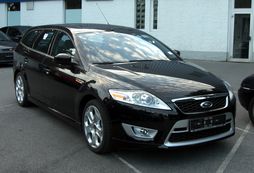
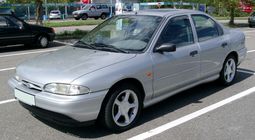
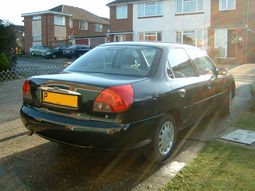
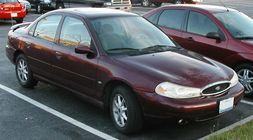


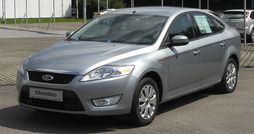
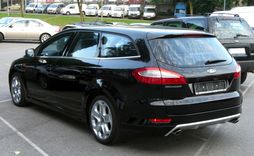
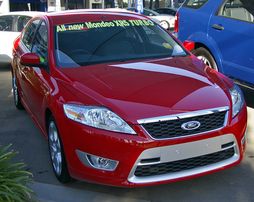
|